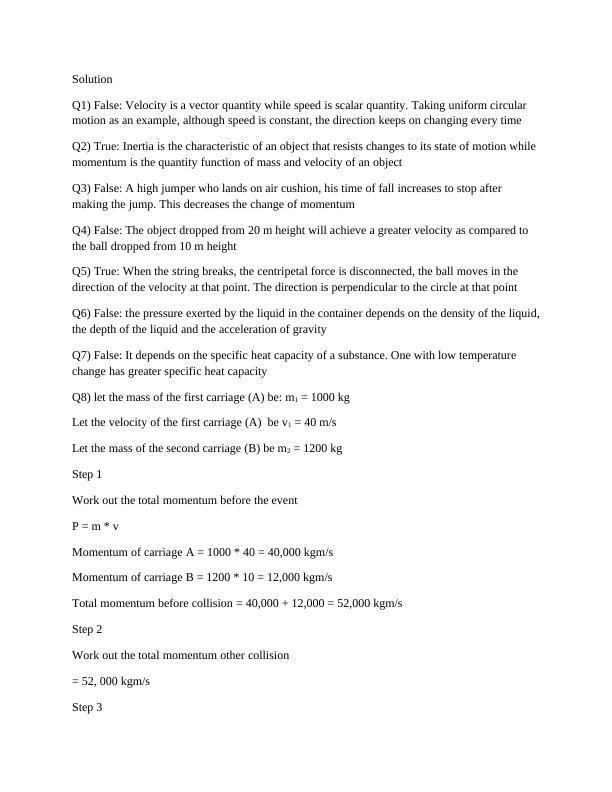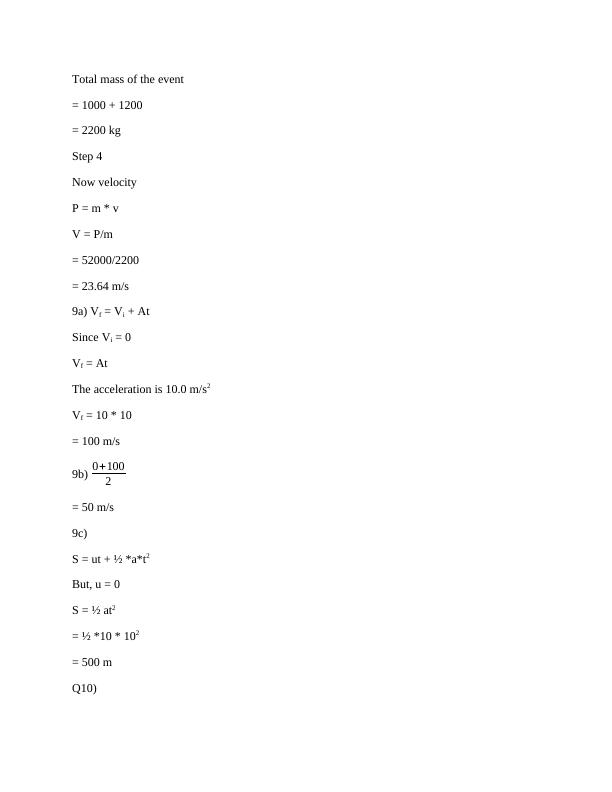Solutions of Physics | Assignment
Added on 2022-08-30
6 Pages786 Words17 Views
Solution
Q1) False: Velocity is a vector quantity while speed is scalar quantity. Taking uniform circular
motion as an example, although speed is constant, the direction keeps on changing every time
Q2) True: Inertia is the characteristic of an object that resists changes to its state of motion while
momentum is the quantity function of mass and velocity of an object
Q3) False: A high jumper who lands on air cushion, his time of fall increases to stop after
making the jump. This decreases the change of momentum
Q4) False: The object dropped from 20 m height will achieve a greater velocity as compared to
the ball dropped from 10 m height
Q5) True: When the string breaks, the centripetal force is disconnected, the ball moves in the
direction of the velocity at that point. The direction is perpendicular to the circle at that point
Q6) False: the pressure exerted by the liquid in the container depends on the density of the liquid,
the depth of the liquid and the acceleration of gravity
Q7) False: It depends on the specific heat capacity of a substance. One with low temperature
change has greater specific heat capacity
Q8) let the mass of the first carriage (A) be: m1 = 1000 kg
Let the velocity of the first carriage (A) be v1 = 40 m/s
Let the mass of the second carriage (B) be m2 = 1200 kg
Step 1
Work out the total momentum before the event
P = m * v
Momentum of carriage A = 1000 * 40 = 40,000 kgm/s
Momentum of carriage B = 1200 * 10 = 12,000 kgm/s
Total momentum before collision = 40,000 + 12,000 = 52,000 kgm/s
Step 2
Work out the total momentum other collision
= 52, 000 kgm/s
Step 3
Q1) False: Velocity is a vector quantity while speed is scalar quantity. Taking uniform circular
motion as an example, although speed is constant, the direction keeps on changing every time
Q2) True: Inertia is the characteristic of an object that resists changes to its state of motion while
momentum is the quantity function of mass and velocity of an object
Q3) False: A high jumper who lands on air cushion, his time of fall increases to stop after
making the jump. This decreases the change of momentum
Q4) False: The object dropped from 20 m height will achieve a greater velocity as compared to
the ball dropped from 10 m height
Q5) True: When the string breaks, the centripetal force is disconnected, the ball moves in the
direction of the velocity at that point. The direction is perpendicular to the circle at that point
Q6) False: the pressure exerted by the liquid in the container depends on the density of the liquid,
the depth of the liquid and the acceleration of gravity
Q7) False: It depends on the specific heat capacity of a substance. One with low temperature
change has greater specific heat capacity
Q8) let the mass of the first carriage (A) be: m1 = 1000 kg
Let the velocity of the first carriage (A) be v1 = 40 m/s
Let the mass of the second carriage (B) be m2 = 1200 kg
Step 1
Work out the total momentum before the event
P = m * v
Momentum of carriage A = 1000 * 40 = 40,000 kgm/s
Momentum of carriage B = 1200 * 10 = 12,000 kgm/s
Total momentum before collision = 40,000 + 12,000 = 52,000 kgm/s
Step 2
Work out the total momentum other collision
= 52, 000 kgm/s
Step 3

Total mass of the event
= 1000 + 1200
= 2200 kg
Step 4
Now velocity
P = m * v
V = P/m
= 52000/2200
= 23.64 m/s
9a) Vf = Vi + At
Since Vi = 0
Vf = At
The acceleration is 10.0 m/s2
Vf = 10 * 10
= 100 m/s
9b) 0+100
2
= 50 m/s
9c)
S = ut + ½ *a*t2
But, u = 0
S = ½ at2
= ½ *10 * 102
= 500 m
Q10)
= 1000 + 1200
= 2200 kg
Step 4
Now velocity
P = m * v
V = P/m
= 52000/2200
= 23.64 m/s
9a) Vf = Vi + At
Since Vi = 0
Vf = At
The acceleration is 10.0 m/s2
Vf = 10 * 10
= 100 m/s
9b) 0+100
2
= 50 m/s
9c)
S = ut + ½ *a*t2
But, u = 0
S = ½ at2
= ½ *10 * 102
= 500 m
Q10)

200 km/hr – 20 km/hr
= 180 km/hr
Q11) T = m*r*w2
= 0.5 * 2 * 42
= 16.0 N
Q12) Energy efficiency = energy output
energy input ∗100
= W out
W ¿
∗100
= M A
VR ∗100
MA = L/E
10 = 200/E
E = 200/10
20.0 kg
Win = effort * effort distance
= 20.0 kg * 20.0 m
= 400.0 J
Power = work
time
= 400/15
= 26.67 watts
Q13) Boyle’s law states that the volume of a given amount of gas is inversely proportional to its
pressure at a constant pressure
v1
p1
= v2
p2
P1 = 100 kPa
= 180 km/hr
Q11) T = m*r*w2
= 0.5 * 2 * 42
= 16.0 N
Q12) Energy efficiency = energy output
energy input ∗100
= W out
W ¿
∗100
= M A
VR ∗100
MA = L/E
10 = 200/E
E = 200/10
20.0 kg
Win = effort * effort distance
= 20.0 kg * 20.0 m
= 400.0 J
Power = work
time
= 400/15
= 26.67 watts
Q13) Boyle’s law states that the volume of a given amount of gas is inversely proportional to its
pressure at a constant pressure
v1
p1
= v2
p2
P1 = 100 kPa

End of preview
Want to access all the pages? Upload your documents or become a member.
Related Documents
Hewitt and Robert Flow Regime | Assignmentlg...
|8
|853
|18
